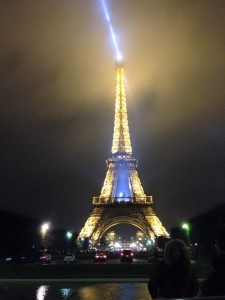On June 8th 2018, I had the pleasure to meet Mr. Peter Knego, the world-renowed ocean liner historian and cruise journalist who has come to Genova to join the MSC Seaview christening and inaugural events. His fame among cruise and ships amateurs is linked to his several trips to Alang -the world’s biggest scrapping yard, in India- to witness the dismantling of many important liners and save furnishings, panels and artworks from destruction. Part of these items are also offered for sale on his website: MidShipCentury.com . His collection has been featured in “The New York Times”, the “Daily News” and “Los Angeles Magazine”. His travels also led to the production of a series of projects: “On the Road to Alang” and “The Sands of Alang” which are also available on his website.
Your passion for maritime history and cruises started in 1973, when you were assigned for a research about the Lusitania. What was the aspect of that story that made you fall in love with maritime matters?
I couldn’t believe that a ship with four funnels sank by the bow only three years after the Titanic. I only knew about the Titanic with four funnles, I didn’t know that there were other ships like that. And I thought that I was very interesting and see about what other ships there were. There was the Mauretania, the  Acquitania, the german liners with four funnels. That was very interesting! There were more ships than I couldn’t imagined, and they were so beautiful with their architectures and lavish interiors. And that was shortly after Maxtone Graham’s book “The Only Way to Cross” was published that is a beautifully written book and anybody, just the average person, would read that and think ocean liners were magnificent creations. So that, and also the movie: “The Poseidon Adventure”. All at the same time made me think ships were fantastic and need to know more, collect brochures and get any book -and there weren’t many books back then- . So I would have to go to the library and try to find prints and magazines, doing researches on the ships… Then I started visiting them in 1974, and that’s when I absolutely fell in love. My first ship was an old british liner: the Arcadia for P&O Lines. A 1954, beautiful wood work, linoleum decking, edge class panels. I was hooked, and that’s when I thought that I had to visit any ship coming to Los Angeles from that moment. I was too young to drive, so my mother or my father had to drive me down, and I would spend my day photographing the ships.
Acquitania, the german liners with four funnels. That was very interesting! There were more ships than I couldn’t imagined, and they were so beautiful with their architectures and lavish interiors. And that was shortly after Maxtone Graham’s book “The Only Way to Cross” was published that is a beautifully written book and anybody, just the average person, would read that and think ocean liners were magnificent creations. So that, and also the movie: “The Poseidon Adventure”. All at the same time made me think ships were fantastic and need to know more, collect brochures and get any book -and there weren’t many books back then- . So I would have to go to the library and try to find prints and magazines, doing researches on the ships… Then I started visiting them in 1974, and that’s when I absolutely fell in love. My first ship was an old british liner: the Arcadia for P&O Lines. A 1954, beautiful wood work, linoleum decking, edge class panels. I was hooked, and that’s when I thought that I had to visit any ship coming to Los Angeles from that moment. I was too young to drive, so my mother or my father had to drive me down, and I would spend my day photographing the ships.
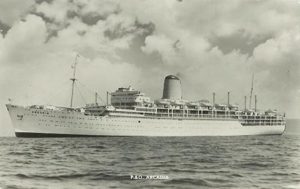
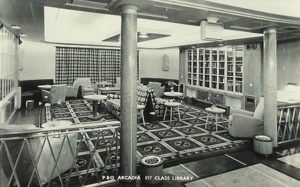
Old liners were conceived as symbols of the best of style, elegance and manufacturing of a nation. Italian liners were designed by great architects and artists such as the Coppedè brothers, Ducrot Studio, Nino Zoncada, Gustavo Pulitzer, Gio Ponti and so on. Why nowadays cruise ships are no more projected by famous architects?
Well, for me ships are now designed by corporate boardrooms. They are designed by company officials who are trying to figure out how to make more money by putting as many people on a ship, and generating revenue with distractions. Surf boards rides, zip-lines and anything to make people want to be on a ship but at the same time they forget that they’re at sea. So, for me is a different thing all together. The old ocean liners, as you said, were meant to be inspirational. The architects, I remember my friend Maurizio (Eliseo, editor’s 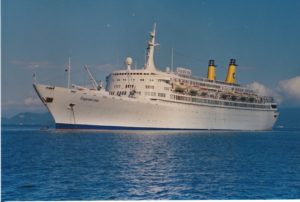 note) told me that here in Italy, when they were designing the Eugenio C, they were arguing for days and days about the curved superstructures of the ship. They had to make beauty before function. Beauty and function is the ultimate, but sometimes you give up a little function for that beauty, so that when people saw the Eugenio C sailing by, they would say that it was a magnificent ship and they would love to sail on her. Not a big giant floating carnival park full of distractions. These new ships are a all different thing. And people today, sadly, at least where I’m from, they don’t care so much if the ship looks beautiful. They want fifteen different specialty restaurants, they want the SPA, they want balconies, they want all these amenities and it makes sense! This is why they go on a cruise, they want these things. So today it is nice to look at those old ships in books but we rather have a big new ship.
note) told me that here in Italy, when they were designing the Eugenio C, they were arguing for days and days about the curved superstructures of the ship. They had to make beauty before function. Beauty and function is the ultimate, but sometimes you give up a little function for that beauty, so that when people saw the Eugenio C sailing by, they would say that it was a magnificent ship and they would love to sail on her. Not a big giant floating carnival park full of distractions. These new ships are a all different thing. And people today, sadly, at least where I’m from, they don’t care so much if the ship looks beautiful. They want fifteen different specialty restaurants, they want the SPA, they want balconies, they want all these amenities and it makes sense! This is why they go on a cruise, they want these things. So today it is nice to look at those old ships in books but we rather have a big new ship.


In your website, MidshipCentury.com , you sell out furnitures, artworks and panels that you litteraly saved from destruction during your numerous travels to Alang, and many of them came from ships that made the history of the Italian maritime history: the Ausonia, EugenioCosta or the Augustus…
… Yes, the most beautiful one! It was heartbreaking because I went to the Philippines in 2000. I spent a week walking the decks of the Augustus, going through the rooms and seeing all the beautiful furnitures, light fixtures and some of the art works were still there onboard. She was so magnificent and so well  preserved. You know, you could go in the cabins and still find Italian Line’s daily programs that were left over from the 70s because nobody touched the ship. She was just kept in immaculate conditions all those years. Then, they opened it as a hotel but she didn’t do so well because nobody wanted to travel to the Philippines. She just sat there and they used her for functions like Miss Universe contests and thing like that, but they didn’t make her an actual functioning hotel. So finally, when the owner was too old, he no longer wanted to keep her. She was like his toy, and that’s when my heart broke, when he sold her for scrap. I thought that of all the ocean liners in the world, she was the one. She needed to come back to Genova and to be right there, on Molo Vecchio (Mr.Knego points the Molo Vecchio while talking, editor’s note). But instead, they wanted the yacht harbour, the fancy yachts. So the plan didn’t happen and she went to Alang. I went to see all the other ships and they all broke my heart, but the Augustus, for me, was the biggest tragedy. To think that she was there, perfectly intact, but they would cut this beautiful sculpture of
preserved. You know, you could go in the cabins and still find Italian Line’s daily programs that were left over from the 70s because nobody touched the ship. She was just kept in immaculate conditions all those years. Then, they opened it as a hotel but she didn’t do so well because nobody wanted to travel to the Philippines. She just sat there and they used her for functions like Miss Universe contests and thing like that, but they didn’t make her an actual functioning hotel. So finally, when the owner was too old, he no longer wanted to keep her. She was like his toy, and that’s when my heart broke, when he sold her for scrap. I thought that of all the ocean liners in the world, she was the one. She needed to come back to Genova and to be right there, on Molo Vecchio (Mr.Knego points the Molo Vecchio while talking, editor’s note). But instead, they wanted the yacht harbour, the fancy yachts. So the plan didn’t happen and she went to Alang. I went to see all the other ships and they all broke my heart, but the Augustus, for me, was the biggest tragedy. To think that she was there, perfectly intact, but they would cut this beautiful sculpture of  a ship into pieces and melt her down. So I made sure that I rescued everything I could. I got furnitures, some of the light fixtures which are now in the Victoria & Albert Museum on display, I have a beautiful panel by Marangoni (Tranquillo Marangoni ndr.), a magnificent wooden panel called “The Green House” (“La serra” in italian, editor’s note). And for some reasons “Italia” didn’t remove it when they sold the ship! Crazy! So now it’s in my house and everyday I walk by pieces of Augustus. I have one of her in tables from the suites in my bedroom, under a panel by Luzzati from Eugenio C stair tower. Then I have another painting by Luzzati from Stella Maris of a circean calypso. He did all panels depicting greek mythology on the Sun Lines ships, just magnificent! And I come here and of course the Museo Luzzati it’s so nice to have, but they have nothing. Only just the drawings that he did in the very end of its life for children. They’re beautiful but nothing compared to what he did for the ocean liners. So I live in a world of Luzzati, Paolucci, Marangoni…
a ship into pieces and melt her down. So I made sure that I rescued everything I could. I got furnitures, some of the light fixtures which are now in the Victoria & Albert Museum on display, I have a beautiful panel by Marangoni (Tranquillo Marangoni ndr.), a magnificent wooden panel called “The Green House” (“La serra” in italian, editor’s note). And for some reasons “Italia” didn’t remove it when they sold the ship! Crazy! So now it’s in my house and everyday I walk by pieces of Augustus. I have one of her in tables from the suites in my bedroom, under a panel by Luzzati from Eugenio C stair tower. Then I have another painting by Luzzati from Stella Maris of a circean calypso. He did all panels depicting greek mythology on the Sun Lines ships, just magnificent! And I come here and of course the Museo Luzzati it’s so nice to have, but they have nothing. Only just the drawings that he did in the very end of its life for children. They’re beautiful but nothing compared to what he did for the ocean liners. So I live in a world of Luzzati, Paolucci, Marangoni…
… It’s a beautful world!
It is a beautiful world! The italians made the most beautiful ships as far as the art works were concerned, light fixtures, furnitures… Magnificent. The british made the most beautiful ships with the wood work in the edge class panels. So I have a combination of the best british and italian… And maybe a little french ships here and there or a couple of other, but the italian ships steal my heart.

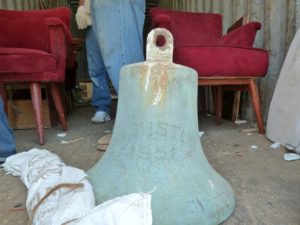
Are there many people who are interested in these items? Who are they? Collectors? Museums or also people who are interested in the design but not about the story of the ships and so on…
That’s it, what you just said there! The interior designers love the italian furniture. If it’s Pulitzer, maybe they like it. But if it’s Ponti, oh my gosh! You know, a Ponti chair, they can sell it for twenty thousand dollars because they say: “Gio Ponti? It doesn’t matter what it looks like, it’s Gio Ponti!”. Zoncada? Exact same thing, he made the same furniture with Cassina for Ponti. Zoncada 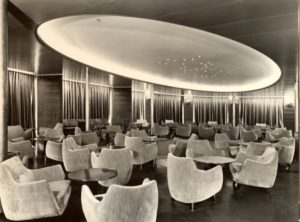 designed and Ponti signed off one of it and said: “Yes, I like that chair, go with it”. But if I say it’s a Zoncada they go: “That’s nice”. But if it’s mid-century italian they’re very interested, because in the States, right now, that’s very popular. But the ship history? No, not so much. If you say Augustus they answer that they don’t know the ship. Andrea Doria? Yes they know off course, but there’s nothing to save from the Andrea Doria that hasn’t been very damaged. With Augustus, there were some light fixtures by Artoluce in Trieste. Those lights are very very valuable as well. I didn’t know when I purchased them, I just thought they were beautiful and I would save them. I sold many of the things but now, with Augustus, everything that I have, I keep. Because when I’m gone in thirty years? Hopefully fourty, hopefully better? I want these things all to be kept together. I
designed and Ponti signed off one of it and said: “Yes, I like that chair, go with it”. But if I say it’s a Zoncada they go: “That’s nice”. But if it’s mid-century italian they’re very interested, because in the States, right now, that’s very popular. But the ship history? No, not so much. If you say Augustus they answer that they don’t know the ship. Andrea Doria? Yes they know off course, but there’s nothing to save from the Andrea Doria that hasn’t been very damaged. With Augustus, there were some light fixtures by Artoluce in Trieste. Those lights are very very valuable as well. I didn’t know when I purchased them, I just thought they were beautiful and I would save them. I sold many of the things but now, with Augustus, everything that I have, I keep. Because when I’m gone in thirty years? Hopefully fourty, hopefully better? I want these things all to be kept together. I  hope the world would be ready for it. I was very happy to see in Galata (Galata Museo del Mare, Genova, editor’s note) the Andrea Doria exhibit. And it was crowded! People were there, they were enjoying it! Maybe ocean liners will make a comeback in people’s minds and they will think: “Okay, what happened to all these ships? Isn’t it nice that some of them still survived?”. Let’s make a museum, just ocean liners, furnitures, art works, fittings. Show the pictures of their glory, show them at the scrapyard because it’s also a very fascinating procedure in India. To see Augustus on the beach, her entire hull out of water. This magnificent creation. Not in a drydock, not at a pier, but fully exposed on a natural beach was, to me, the most beautiful thing and at the same time very sad, because it was just for a very short period of time before they started demolishing her. But, to see the pictures, and I believe you had, to see her looking so magnificent, powerful…
hope the world would be ready for it. I was very happy to see in Galata (Galata Museo del Mare, Genova, editor’s note) the Andrea Doria exhibit. And it was crowded! People were there, they were enjoying it! Maybe ocean liners will make a comeback in people’s minds and they will think: “Okay, what happened to all these ships? Isn’t it nice that some of them still survived?”. Let’s make a museum, just ocean liners, furnitures, art works, fittings. Show the pictures of their glory, show them at the scrapyard because it’s also a very fascinating procedure in India. To see Augustus on the beach, her entire hull out of water. This magnificent creation. Not in a drydock, not at a pier, but fully exposed on a natural beach was, to me, the most beautiful thing and at the same time very sad, because it was just for a very short period of time before they started demolishing her. But, to see the pictures, and I believe you had, to see her looking so magnificent, powerful…

..Right, it was so sad. Heartbreaking.
Yeah, well the scrapping pictures expecially. Terrible! But, what can you do? Nobody could save her. At least, when they scrap the ships in Alang, they have the market. Where people like me can buy things and save them. So that’s the one good thing: at least part of Augustus survived today.
And which was your most memorable trip to Alang? Maybe when there was a particular ship…
When Aureol… A british ocean liner which is almost as beautiful as Augustus. A 1951, hundred percent intact also because she was bought by the Greek billionaire John Latsis. He saved her, he loved british liners and used her as an 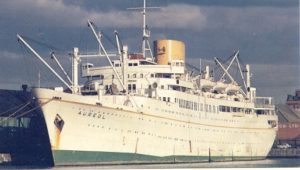 accomodation ship in the middle east. Never changed, never updated. So when she went for scrap, that’s when I thought that I had to start buying things. I was afraid to go to India, I didn’t have any contact, I didn’t know what it was like there. I am mad at myself because you know, they say that In life it’s not the things that you do that you regret, it’s the things you don’t do. And I wish I went for Aureol. She was also there with the Principe Perfeito, which was a portuguese liner –british built- also very beautiful. So I bought things from those ships and when they came to my home I said: “Next time an important ship goes, since I have made a contact in India that is going to help me, I’m going”. So there were nine or ten ships, all at once: the Empress of Canada, the Transvaal Castle, the Stella Solaris which was filled with Luzzati, Stella Oceanis also with Luzzati… And when all those ships were there I thought: “This is it, I’m going!”. And I wish I spent more time there. I booked two weeks, I took a week off and went to Delhi and the Taj Mahal, because everyone wants to see those things, but they will be there forever! And I wish I had that extra week in Alang because there were so many more things that I could have done, seen and documented. But that was the trip and then I decided after that, once I have made my friend
accomodation ship in the middle east. Never changed, never updated. So when she went for scrap, that’s when I thought that I had to start buying things. I was afraid to go to India, I didn’t have any contact, I didn’t know what it was like there. I am mad at myself because you know, they say that In life it’s not the things that you do that you regret, it’s the things you don’t do. And I wish I went for Aureol. She was also there with the Principe Perfeito, which was a portuguese liner –british built- also very beautiful. So I bought things from those ships and when they came to my home I said: “Next time an important ship goes, since I have made a contact in India that is going to help me, I’m going”. So there were nine or ten ships, all at once: the Empress of Canada, the Transvaal Castle, the Stella Solaris which was filled with Luzzati, Stella Oceanis also with Luzzati… And when all those ships were there I thought: “This is it, I’m going!”. And I wish I spent more time there. I booked two weeks, I took a week off and went to Delhi and the Taj Mahal, because everyone wants to see those things, but they will be there forever! And I wish I had that extra week in Alang because there were so many more things that I could have done, seen and documented. But that was the trip and then I decided after that, once I have made my friend 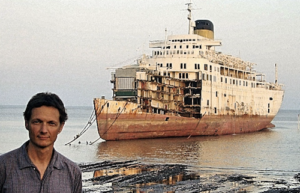 there, and he took good care of me and snuck me into the yards and he understood my passion and fell in love with the ships himself, that’s when I said: “Next time another important old liner goes to India, I’m going”. And that next ships was Eugenio C… And then Windor Castle. Both were there at the same time. So I made that second trip and so on. Everytime, expecially the italian liners. The Lloyd Triestino’s Victoria, which was Anastasis in her last. Again, another ship one hundred percent intact! Just as designed, because she was a christian missionary ship, so nobody updated her with, you know, new condominium type of staterooms. So she was also beautiful and I got many things from her as well. And then Ausonia…
there, and he took good care of me and snuck me into the yards and he understood my passion and fell in love with the ships himself, that’s when I said: “Next time another important old liner goes to India, I’m going”. And that next ships was Eugenio C… And then Windor Castle. Both were there at the same time. So I made that second trip and so on. Everytime, expecially the italian liners. The Lloyd Triestino’s Victoria, which was Anastasis in her last. Again, another ship one hundred percent intact! Just as designed, because she was a christian missionary ship, so nobody updated her with, you know, new condominium type of staterooms. So she was also beautiful and I got many things from her as well. And then Ausonia…
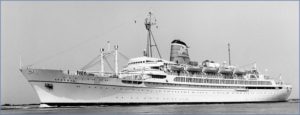
… Oh the Ausonia! What a beautiful ship!
Yes, I sailed on her both as Ausonia and Ivory. And we went on her as Winner 5 when she was on the beach in Alang. The tides came and they were 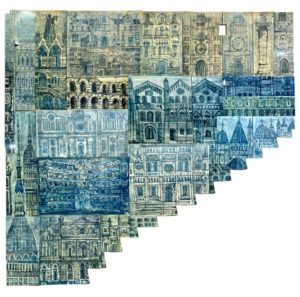 very rough, so they said that we had to spend the night onboard. She was abandoned and it was very sad and very… wet! But it was a magnificent experience because I had all the time I wanted to go wander to the officer’s quarter, and find the builders plan, logbooks and all of the things that I never would have been able to see because usually, when you go on a ship, they rush you and get you off. So that was lovely, I spent one last night on Ausonia in the suite that I sailed in on the ship when she was still sailing with Louis. Althought it was a little more dirty and sticky! But she was a lovely, lovely ship!
very rough, so they said that we had to spend the night onboard. She was abandoned and it was very sad and very… wet! But it was a magnificent experience because I had all the time I wanted to go wander to the officer’s quarter, and find the builders plan, logbooks and all of the things that I never would have been able to see because usually, when you go on a ship, they rush you and get you off. So that was lovely, I spent one last night on Ausonia in the suite that I sailed in on the ship when she was still sailing with Louis. Althought it was a little more dirty and sticky! But she was a lovely, lovely ship!
You are also a cruise journalist: in your experience, how an european ship is perceived by the average US passenger?
Good question! There are two types of US passengers: there are the ones who want to stay in the US and are afraid of anything that is not american. They want american food, american service, american movies, everything has to be in english. They take Carnival, Royal Caribbean, Norwegian. They stay in the Caribbean, they do Alaska… Somebody who comes 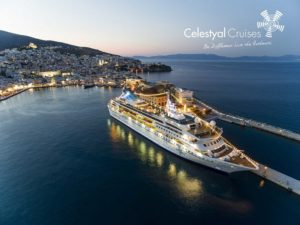 here and sail on an MSC: they are expecting a european experience. They like to travel with different people, different cultures, different languages, eat different food. Those are the types of americans that I like. Because they understand the world and didn’t think that the world revolves around America. And those people are much more fun to be with than the typical american passenger. So I would never come to Europe and sail on Disney, or NCL or Carnival. Not that they’re bad, they’re fine, they’re very good product. But I would much rather experience a european product when I’m travelling in Europe. Greek ships in Greece, italian ships in the Mediterranean.
here and sail on an MSC: they are expecting a european experience. They like to travel with different people, different cultures, different languages, eat different food. Those are the types of americans that I like. Because they understand the world and didn’t think that the world revolves around America. And those people are much more fun to be with than the typical american passenger. So I would never come to Europe and sail on Disney, or NCL or Carnival. Not that they’re bad, they’re fine, they’re very good product. But I would much rather experience a european product when I’m travelling in Europe. Greek ships in Greece, italian ships in the Mediterranean.
Regional products and regional experiences!
Yes, exactly!!
Here in Europe, many cruisers are interested in the cultural aspect of the travel. In the American market, is there a similar interest on these aspects while cruising in the American areas?
Yes, there are the smaller ships. The expedition type ships. There’s a company called UnCruise in Seattle, they have 50-60 passengers on their ships, and they go to Alaska. Those people love getting on a Zodiak and riding into the ice fields of a glacier or taking a hike on a trail looking for bears. That type of things, getting  very into the experience. When the people on the Carnival or NCL ships are going to Alaska, they’re going to Juneau and Ketchikan, and they’re going to giant shopping malls, and if they have a lot of money maybe they fly over a glacier. But they are not touching and feeling and experiencing the place that plus. So there’s a big difference. But there are ships, and there are americans, I should say, there’s a wide variety of americans fortunately. And there are certain ships: Oceania, Viking and Azamara. Those cruise lines cater to a more cultured type of passenger. They want to eat good food, they want to have good enrichment lectures and they want to go on excursions where they can actually learn and experience. So it’s not just about going to the rum bar and having an extra drink or two. Or doing a wet t-shirt contest… It’s an all different kind of passenger! So there are some lines that cater to the people who want culture, and lines who cater to the people want to party. There’s something for everybody in America.
very into the experience. When the people on the Carnival or NCL ships are going to Alaska, they’re going to Juneau and Ketchikan, and they’re going to giant shopping malls, and if they have a lot of money maybe they fly over a glacier. But they are not touching and feeling and experiencing the place that plus. So there’s a big difference. But there are ships, and there are americans, I should say, there’s a wide variety of americans fortunately. And there are certain ships: Oceania, Viking and Azamara. Those cruise lines cater to a more cultured type of passenger. They want to eat good food, they want to have good enrichment lectures and they want to go on excursions where they can actually learn and experience. So it’s not just about going to the rum bar and having an extra drink or two. Or doing a wet t-shirt contest… It’s an all different kind of passenger! So there are some lines that cater to the people who want culture, and lines who cater to the people want to party. There’s something for everybody in America.
Small ships are leaving the fleets of many major cruise companies. Here in Italy those who started cruising on more “traditional” ships are also pretty reluctant about traveling aboard 5/6000 passengers ships. So, what will be the future of small ships?
Well, it’s funny because I was with a fellow journalist who was on the Seaview and she was telling me about her experience on an old ship. And I said: “What ship was that?” and she said: “Oh it was the Norwegian Gem”. Like, that’s not an old ship! She was like: “Oh she’s so small, and doesn’t have any attractions”. And I’m like: “Ok, ok, but it’s a new ship! It’s got this special ship inside of a ship, it’s got the balconies, a nice spa… And she was like: “No no no, I work with travel 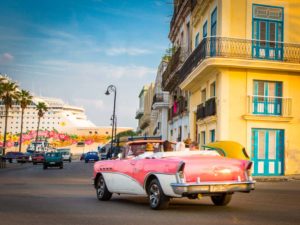 agencies and we consider that an old ship”. And I’m like: “Well, I’m getting very old than, because that’s not an old ship to me”. But that is the way people are thinking. You know, there is a race car riding on the new NCL ship and everybody’s coming up with some new “crazy but fun” thing. Like on the Seaview, she got a lot of things: she got a zip-line and an incredible waterpark. I think those other ships that are smaller ships but too big to me, they are ok for now because there are some markets in the US where they fit perfectly. Short cruises to the Bahamas -Carnival is using their old eight Fantasy Class ships to do those- or cruises to Mexico from Los Angeles. So, as long as there are small markets like that, the small to medium size ships have a home. Now Cuba has opened up, and you can’t get the big ships to Havana, and that’s the biggest port in Cuba. So some of the ships like the old Empress by Royal Caribbean has now come back into the fleet, and she’s popular because she’s perfect for that itinerary. So as long as there are certain itineraries like that, it’s good. I think those ships will be in big trouble if another bad incident happens. A highjacking , a terrorist thing or some disasters like the Concordia, those are the first ships to go. They will have troubles in being filled if the market get damaged, but the market it’s very healthy right now.
agencies and we consider that an old ship”. And I’m like: “Well, I’m getting very old than, because that’s not an old ship to me”. But that is the way people are thinking. You know, there is a race car riding on the new NCL ship and everybody’s coming up with some new “crazy but fun” thing. Like on the Seaview, she got a lot of things: she got a zip-line and an incredible waterpark. I think those other ships that are smaller ships but too big to me, they are ok for now because there are some markets in the US where they fit perfectly. Short cruises to the Bahamas -Carnival is using their old eight Fantasy Class ships to do those- or cruises to Mexico from Los Angeles. So, as long as there are small markets like that, the small to medium size ships have a home. Now Cuba has opened up, and you can’t get the big ships to Havana, and that’s the biggest port in Cuba. So some of the ships like the old Empress by Royal Caribbean has now come back into the fleet, and she’s popular because she’s perfect for that itinerary. So as long as there are certain itineraries like that, it’s good. I think those ships will be in big trouble if another bad incident happens. A highjacking , a terrorist thing or some disasters like the Concordia, those are the first ships to go. They will have troubles in being filled if the market get damaged, but the market it’s very healthy right now.
CREDIT PHOTOS: The New York Times archive, Simplonpc.co.uk , Maritime Matters, MidShipCentury.com , Adriatica.altervista.org , CelestyalCruises.com , UN Cruises.com and Norwegian Cruise Lines.com


 Sopravvissuta nella sua essenza allo scorrere inesorabile e talvolta nefasto del tempo, come le correnti del fiume Elba che ne hanno forse eroso le rive, o i bombardamenti della seconda guerra mondiale che l’hanno avvolta tra le fiamme, ridotta in cenere e macerie, ma mai scalfita al punto da vedere traviata la propria identità di polo commerciale di grande rilevanza e di capitale di inestimabile valore storico e culturale.
Sopravvissuta nella sua essenza allo scorrere inesorabile e talvolta nefasto del tempo, come le correnti del fiume Elba che ne hanno forse eroso le rive, o i bombardamenti della seconda guerra mondiale che l’hanno avvolta tra le fiamme, ridotta in cenere e macerie, ma mai scalfita al punto da vedere traviata la propria identità di polo commerciale di grande rilevanza e di capitale di inestimabile valore storico e culturale.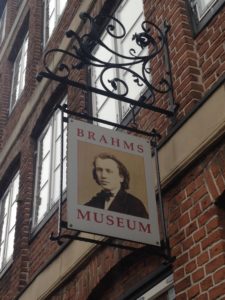 Una città che tanto ammaliò uno dei suoi più illustri cittadini, Johannes Brahms, che perfino durante la sua lunga vita a Vienna ne rimpiangeva i panorami sugli argini e le passeggiate tra le vie natali. L’anti-Wagner che aveva fatto del gusto classicheggiante della società capitalista borghese della Grunderzeit, legata al bisogno di valori certificati da un passato illustre, il cardine compositivo delle sue opere che è ben evidente anche come leif-motiv della pluricentenaria vita amburghese.
Una città che tanto ammaliò uno dei suoi più illustri cittadini, Johannes Brahms, che perfino durante la sua lunga vita a Vienna ne rimpiangeva i panorami sugli argini e le passeggiate tra le vie natali. L’anti-Wagner che aveva fatto del gusto classicheggiante della società capitalista borghese della Grunderzeit, legata al bisogno di valori certificati da un passato illustre, il cardine compositivo delle sue opere che è ben evidente anche come leif-motiv della pluricentenaria vita amburghese.
 Come Georg Philipp Telemann, che definì sagacemente Amburgo come: “la città in cui la musica sembra aver trovato la propria patria”; Carl Philipp Emanuel Bach, meglio conosciuto come: “il Bach di Amburgo”; Johan Adolf Hasse, che cominciò la propria carriera presso la Hamburg Opera House di Gansemarkt; Fanny e Felix Mendelssohn, entrambi nati ad Amburgo e Gustav Mahler, che si trasferì ad Amburgo nel 1891 per ricoprire la carica di Primo Direttore presso l’Hamburg Stadt Theater. Le loro storie e il loro genio raccolto in poche sale, tra partiture originali, libretti e strumenti che permettono di ripercorrere in un avvincente itinerario storico, culturale e artistico la vita di Amburgo “in musica”, dal barocco all’età moderna. Il tutto, in una cornice deliziosamente curata dai numerosi volontari della “Johannes – Brahms – Gesellshaft Internationale Vereiningung e V.”, fondata nel 1969.
Come Georg Philipp Telemann, che definì sagacemente Amburgo come: “la città in cui la musica sembra aver trovato la propria patria”; Carl Philipp Emanuel Bach, meglio conosciuto come: “il Bach di Amburgo”; Johan Adolf Hasse, che cominciò la propria carriera presso la Hamburg Opera House di Gansemarkt; Fanny e Felix Mendelssohn, entrambi nati ad Amburgo e Gustav Mahler, che si trasferì ad Amburgo nel 1891 per ricoprire la carica di Primo Direttore presso l’Hamburg Stadt Theater. Le loro storie e il loro genio raccolto in poche sale, tra partiture originali, libretti e strumenti che permettono di ripercorrere in un avvincente itinerario storico, culturale e artistico la vita di Amburgo “in musica”, dal barocco all’età moderna. Il tutto, in una cornice deliziosamente curata dai numerosi volontari della “Johannes – Brahms – Gesellshaft Internationale Vereiningung e V.”, fondata nel 1969.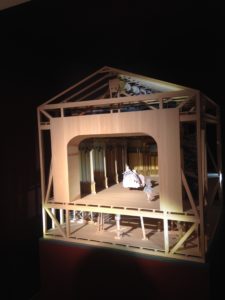
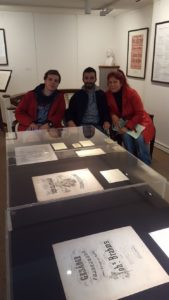
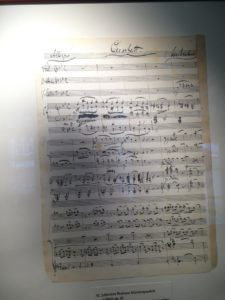
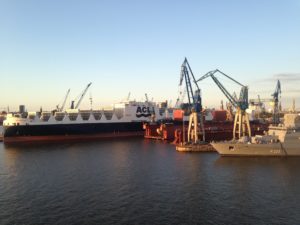

 Amburgo, costruito nel 1875 e inizialmente adibito al deposito di cacao, tabacco e tè- in una struttura avveniristica: un auditorium unico nel suo genere progettato da Pierre de Meuron, Jacques Herzog e Ascan Mergenthaler. La struttura è inserita nella suggestiva cornice del porto di Amburgo, lungo il fiume Elba. Al suo interno: una Grand Hall da 2.100 posti, una recital hall e una sala da 150 posti specificamente progettata per seminari e workshops curati dal programma di educazione musicale: “World of Instruments”. Ma anche un hotel, un ristorante birreria, una terrazza panoramica e quarantacinque lussuosi appartamenti. Una maestosa struttura in vetro curvato, come un grande cristallo incastonato nella città. Nei suoi 1000
Amburgo, costruito nel 1875 e inizialmente adibito al deposito di cacao, tabacco e tè- in una struttura avveniristica: un auditorium unico nel suo genere progettato da Pierre de Meuron, Jacques Herzog e Ascan Mergenthaler. La struttura è inserita nella suggestiva cornice del porto di Amburgo, lungo il fiume Elba. Al suo interno: una Grand Hall da 2.100 posti, una recital hall e una sala da 150 posti specificamente progettata per seminari e workshops curati dal programma di educazione musicale: “World of Instruments”. Ma anche un hotel, un ristorante birreria, una terrazza panoramica e quarantacinque lussuosi appartamenti. Una maestosa struttura in vetro curvato, come un grande cristallo incastonato nella città. Nei suoi 1000  pannelli, non solo sembrano specchiarsi i campanili delle grandi chiese di San Michele e San Pietro, o la vetta in bronzo del grandioso municipio neorinascimentale, ma anche le luci, i colori e i riflessi lungo il torbido corso dell’Elba. Attraverso cui, ancora oggi, navigano lente e solenni grandi navi che con tre fischi lunghi sembrano rendere omaggio a questa, seppur moderna, pietra miliare nel costante processo evolutivo di una grandiosa capitale culturale.
pannelli, non solo sembrano specchiarsi i campanili delle grandi chiese di San Michele e San Pietro, o la vetta in bronzo del grandioso municipio neorinascimentale, ma anche le luci, i colori e i riflessi lungo il torbido corso dell’Elba. Attraverso cui, ancora oggi, navigano lente e solenni grandi navi che con tre fischi lunghi sembrano rendere omaggio a questa, seppur moderna, pietra miliare nel costante processo evolutivo di una grandiosa capitale culturale.
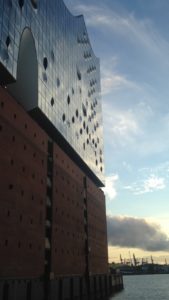



 Di Roma, Giotto diceva che è la città degli echi, la città delle illusioni, e la città del desiderio. Ma se avesse potuto spiare dal buco della serratura del portone del Giardino degli Aranci all’Aventino, da cui si vede il celeberrimo “cupolone” di San Pietro, avrebbe aggiunto che Roma è senz’altro anche la città delle grandi sorprese e dei tesori celati. Come il Chiostro del Bramante che, se viaggiate in
Di Roma, Giotto diceva che è la città degli echi, la città delle illusioni, e la città del desiderio. Ma se avesse potuto spiare dal buco della serratura del portone del Giardino degli Aranci all’Aventino, da cui si vede il celeberrimo “cupolone” di San Pietro, avrebbe aggiunto che Roma è senz’altro anche la città delle grandi sorprese e dei tesori celati. Come il Chiostro del Bramante che, se viaggiate in 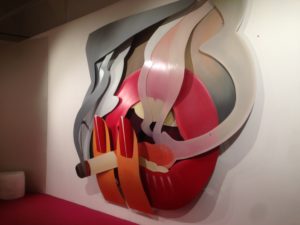 coppia e non vi siete ancora innamorati lungo la passeggiata del Pincio che sovrasta i tetti rossi del centro e le fontane di Piazza del Popolo, o se affrontate una visita in solitaria e cercate di innamorarvi a Roma e di Roma come in un film di Fellini, offre fino al 19 Febbraio 2017 una mostra dal titolo che potrebbe guidarvi verso il vostro
coppia e non vi siete ancora innamorati lungo la passeggiata del Pincio che sovrasta i tetti rossi del centro e le fontane di Piazza del Popolo, o se affrontate una visita in solitaria e cercate di innamorarvi a Roma e di Roma come in un film di Fellini, offre fino al 19 Febbraio 2017 una mostra dal titolo che potrebbe guidarvi verso il vostro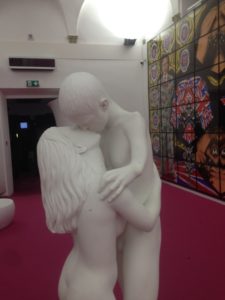 o della letteratura come Leopardi o Dante Alighieri, nelle sue forme più lontane e distaccate, come l’amore plastico di Tom Wesselmann in “smoker”, l’adorazione a tratti feticista di quelle labbra rosse e quella sigaretta pendente avvolta in una nube di fumo grigio, dagli evidenti richiami ad un’ ideale di sensualità che posa le sue radici nel fascino delle grandi dive come Marlene Dietrich, Anita Ekberg o Ava Gardner e che, per chi lo ricorda, potrà far tornare alla mente i mille accendini pronti ad accendere la sigaretta di “Malena” nel film di Giuseppe Tornatore. Serie di opere che, tra l’altro, ispirò persino i Rolling Stones per la loro cover di Sticky Fingers.
o della letteratura come Leopardi o Dante Alighieri, nelle sue forme più lontane e distaccate, come l’amore plastico di Tom Wesselmann in “smoker”, l’adorazione a tratti feticista di quelle labbra rosse e quella sigaretta pendente avvolta in una nube di fumo grigio, dagli evidenti richiami ad un’ ideale di sensualità che posa le sue radici nel fascino delle grandi dive come Marlene Dietrich, Anita Ekberg o Ava Gardner e che, per chi lo ricorda, potrà far tornare alla mente i mille accendini pronti ad accendere la sigaretta di “Malena” nel film di Giuseppe Tornatore. Serie di opere che, tra l’altro, ispirò persino i Rolling Stones per la loro cover di Sticky Fingers.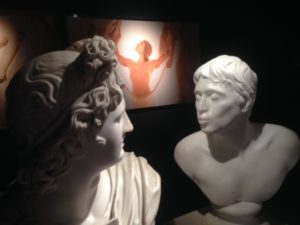 insegnato ad apprezzare nonché accettare, mostrandoci un tenero bacio tra due persone affette da sindrome di Dawn. Ma amore anche per l’arte, appunto, ad opera del bresciano Francesco Vezzoli, che in una serie di squisiti confronti -la cui protagonista indiscussa è Eva Mendes, oltre che lo stesso artista ritratto in un busto impegnato a rubare un bacio ad un affascinante e giovane Apollo- ci mostra il narcisismo dell’età moderna che si specchia con la bellezza classica di opere come la nascita di Venere di Ludovisi, il trionfo di Paolina Borghese e l’Estasi di Santa Teresa.
insegnato ad apprezzare nonché accettare, mostrandoci un tenero bacio tra due persone affette da sindrome di Dawn. Ma amore anche per l’arte, appunto, ad opera del bresciano Francesco Vezzoli, che in una serie di squisiti confronti -la cui protagonista indiscussa è Eva Mendes, oltre che lo stesso artista ritratto in un busto impegnato a rubare un bacio ad un affascinante e giovane Apollo- ci mostra il narcisismo dell’età moderna che si specchia con la bellezza classica di opere come la nascita di Venere di Ludovisi, il trionfo di Paolina Borghese e l’Estasi di Santa Teresa. l’ideale di amore sul quale Vanessa Beecroft vorrà farvi riflettere, o sulla nascita e la degenerazione del sentimento -per mezzo del linguaggio cinematografico- secondo Tracey Moffett.
l’ideale di amore sul quale Vanessa Beecroft vorrà farvi riflettere, o sulla nascita e la degenerazione del sentimento -per mezzo del linguaggio cinematografico- secondo Tracey Moffett.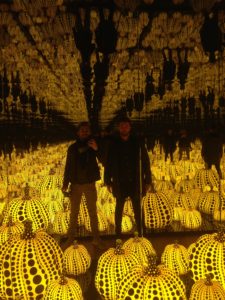

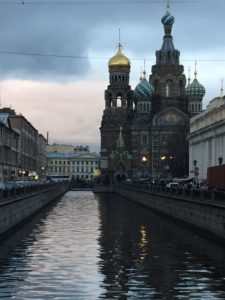 dei Balcani e ad est delle grandi capitali centenarie di una allora Europa ancora scossa dalla Guerra di Secessione Spagnola e dalla Grande Guerra del Nord, un moderno Cezar – da questo il nome Zar, per l’appunto- di nome Pietro il Grande decise, nel Maggio del 1703, di deporre la prima pietra sul terreno paludoso dell’isola delle Lepri per dare inizio alla costruzione di una capitale che, con la cooperazione delle più grandi “archi-star” del XVI Secolo- tra cui il ticinese Domenico Trezzini e il napoletano Carlo Rossi- potesse dimostrare a sovrani, ambasciatori e grandi menti dell’epoca dei lumi che una nuova potenza stava per far sentire il proprio ruggito oltre il Danubio dalle acque ghiacciate decantato da Ovidio nel Tristia: l’Impero Russo.
dei Balcani e ad est delle grandi capitali centenarie di una allora Europa ancora scossa dalla Guerra di Secessione Spagnola e dalla Grande Guerra del Nord, un moderno Cezar – da questo il nome Zar, per l’appunto- di nome Pietro il Grande decise, nel Maggio del 1703, di deporre la prima pietra sul terreno paludoso dell’isola delle Lepri per dare inizio alla costruzione di una capitale che, con la cooperazione delle più grandi “archi-star” del XVI Secolo- tra cui il ticinese Domenico Trezzini e il napoletano Carlo Rossi- potesse dimostrare a sovrani, ambasciatori e grandi menti dell’epoca dei lumi che una nuova potenza stava per far sentire il proprio ruggito oltre il Danubio dalle acque ghiacciate decantato da Ovidio nel Tristia: l’Impero Russo.
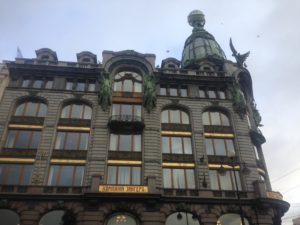 nz’altro la Gostiny Dvor costruita nel 1721, l’imponente facciata art-nouveau della storica libreria Dom Knigi, la Cattedrale di Kazan’ costruita da Andrej Voronichin sul modello della Basilica di San Pietro, fino alla Cattedrale di Sant’Isacco e il Palazzo dell’Ammiragliato, le cui vette dorate fendono ancora oggi la nebbia delle prime ore del mattino.
nz’altro la Gostiny Dvor costruita nel 1721, l’imponente facciata art-nouveau della storica libreria Dom Knigi, la Cattedrale di Kazan’ costruita da Andrej Voronichin sul modello della Basilica di San Pietro, fino alla Cattedrale di Sant’Isacco e il Palazzo dell’Ammiragliato, le cui vette dorate fendono ancora oggi la nebbia delle prime ore del mattino.
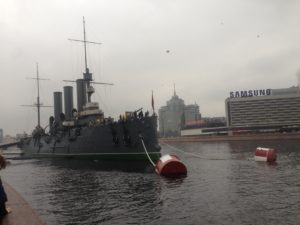 continueranno ad esserci e a conoscere inesorabilmente quella parte di un patrimonio comune, in quanto parte di una identità nazionale e culturale, che neppure la severità del dominio zarista, le baionette dei bolscevichi o la dissoluzione del regime sono riusciti a ledere.
continueranno ad esserci e a conoscere inesorabilmente quella parte di un patrimonio comune, in quanto parte di una identità nazionale e culturale, che neppure la severità del dominio zarista, le baionette dei bolscevichi o la dissoluzione del regime sono riusciti a ledere.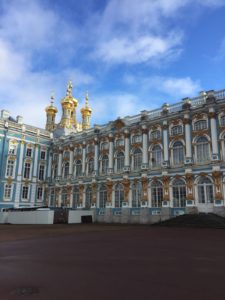 abbandonato dopo la Rivoluzione di Ottobre e conquistato dalle truppe naziste durante l’assedio di Leningrado, razziato, dato alla fiamme durante la fuga e sapientemente restaurato già a partire dagli anni subito successivi al conflitto. Completato solo nel 2003, ad oggi definito come: “uno dei più grandi successi mediatici di Vladimir Putin” o il tesoro dell’Hermitage conservato in oltre trenta chilometri di sale divise in cinque differenti palazzi e che, tra lampadari d’argento, intarsi in madreperla, imponenti colonnati, portoni in ebano, bronzo e guscio di tartaruga e una impressionante copia delle celeberrime Logge di Raffaello, ospita collezioni e pezzi unici come “Bacio di Cupido e Psiche” di Canova,
abbandonato dopo la Rivoluzione di Ottobre e conquistato dalle truppe naziste durante l’assedio di Leningrado, razziato, dato alla fiamme durante la fuga e sapientemente restaurato già a partire dagli anni subito successivi al conflitto. Completato solo nel 2003, ad oggi definito come: “uno dei più grandi successi mediatici di Vladimir Putin” o il tesoro dell’Hermitage conservato in oltre trenta chilometri di sale divise in cinque differenti palazzi e che, tra lampadari d’argento, intarsi in madreperla, imponenti colonnati, portoni in ebano, bronzo e guscio di tartaruga e una impressionante copia delle celeberrime Logge di Raffaello, ospita collezioni e pezzi unici come “Bacio di Cupido e Psiche” di Canova, 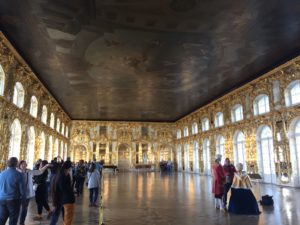 la “Madonna di Benois” di Leonardo da Vinci, il “San Sebastiano” di Perugino e “Ritorno del figliol prodigo” di Rembrandt, oltre che sculture classiche, vasi e portici in malachite, sarcofagi egizi, papiri e steli acquistate negli anni dagli ambasciatori della famiglia imperiale.
la “Madonna di Benois” di Leonardo da Vinci, il “San Sebastiano” di Perugino e “Ritorno del figliol prodigo” di Rembrandt, oltre che sculture classiche, vasi e portici in malachite, sarcofagi egizi, papiri e steli acquistate negli anni dagli ambasciatori della famiglia imperiale.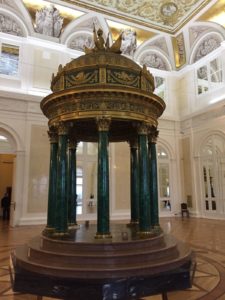 dimora della aristocratica e poderosa famiglia Yusupov, nota per aver dato i natali al marito della affascinante principessa Irina Aleksandrovna Romanov: Feliks Feliksovic Yusupov. Colui che, nella notte tra il 16 e il 17 Dicembre 1916, partecipò al complotto per
dimora della aristocratica e poderosa famiglia Yusupov, nota per aver dato i natali al marito della affascinante principessa Irina Aleksandrovna Romanov: Feliks Feliksovic Yusupov. Colui che, nella notte tra il 16 e il 17 Dicembre 1916, partecipò al complotto per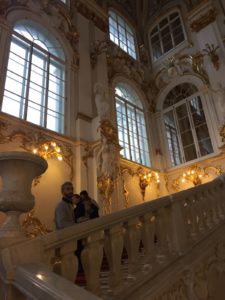 erlato è ancora un piatto fortemente consigliato insieme alla tipica Kulebyaka di carne di coniglio e il caviale -“l’oro nero della Russia”- che resta insieme al balletto e le ceramiche policrome della Chiesa del Salvatore sul Sangue Versato, il grande orgoglio della Russia. Una serata di buona cucina, musica, balli e costumi tradizionali è invece il piatto forte del celebre Ristorante Katyusha, decorato da pizzi, vassoi in stile tradizionale Zhostovo e divani avvolti da morbidi scialli Pavloposadsky, per brindare con una vodka all’urlo di “Nazdarovja!” e provare una Russish Salad che, vi stupirà sapere, si tratta dell’autentica insalata russa.
erlato è ancora un piatto fortemente consigliato insieme alla tipica Kulebyaka di carne di coniglio e il caviale -“l’oro nero della Russia”- che resta insieme al balletto e le ceramiche policrome della Chiesa del Salvatore sul Sangue Versato, il grande orgoglio della Russia. Una serata di buona cucina, musica, balli e costumi tradizionali è invece il piatto forte del celebre Ristorante Katyusha, decorato da pizzi, vassoi in stile tradizionale Zhostovo e divani avvolti da morbidi scialli Pavloposadsky, per brindare con una vodka all’urlo di “Nazdarovja!” e provare una Russish Salad che, vi stupirà sapere, si tratta dell’autentica insalata russa.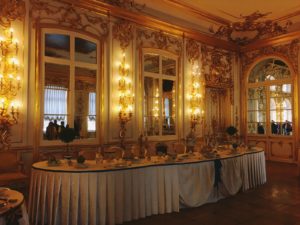

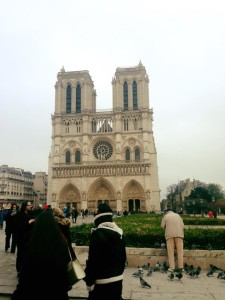 vertirsi al cristianesimo per salire sul trono di Francia, è la prima frase che viene in mente quando, al termine degli scalini umidi di pioggia della fermata Saint-Michel del Metro B della capitale francese, ci si ritrova immersi nell’aria gelida e pungente che soffia lungo la Senna sotto il cielo plumbeo di una giornata di fine Novembre e il consueto accalcarsi indistinto di turisti tra la Rue de la Cite’, la Promenade di Quai Saint-Michel e il portale del Giudizio Universale della cathedrale di Francia.
vertirsi al cristianesimo per salire sul trono di Francia, è la prima frase che viene in mente quando, al termine degli scalini umidi di pioggia della fermata Saint-Michel del Metro B della capitale francese, ci si ritrova immersi nell’aria gelida e pungente che soffia lungo la Senna sotto il cielo plumbeo di una giornata di fine Novembre e il consueto accalcarsi indistinto di turisti tra la Rue de la Cite’, la Promenade di Quai Saint-Michel e il portale del Giudizio Universale della cathedrale di Francia.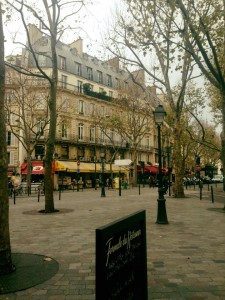 biglietterie dei bateau mouche c’è una camionetta della Gendarmerie de France, ad appena otto giorni dagli attentati terroristici del 13 Novembre 2015, i riflessi dell’Ala Denon del Louvre sulla superficie increspata della Senna passano in secondo piano e c’è chi preferisce inquadrare nel proprio obiettivo i giubbotti anti proiettili del gendarme che tanto ricordano quelli già visti nelle riprese della drammatica incursione al Bataclan o alla sede di Charlie Hebdo.
biglietterie dei bateau mouche c’è una camionetta della Gendarmerie de France, ad appena otto giorni dagli attentati terroristici del 13 Novembre 2015, i riflessi dell’Ala Denon del Louvre sulla superficie increspata della Senna passano in secondo piano e c’è chi preferisce inquadrare nel proprio obiettivo i giubbotti anti proiettili del gendarme che tanto ricordano quelli già visti nelle riprese della drammatica incursione al Bataclan o alla sede di Charlie Hebdo.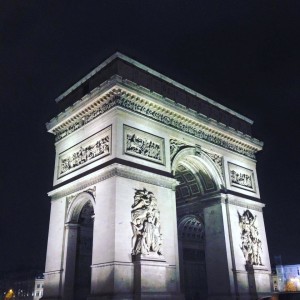 cui a viso scoperto la Ville Lumiere non si fa spegnere nemmeno da 118 morti nel X Arroundisment, a quindici minuti dal Parlamento. In una sorta di revanchismo del XXI Secolo, la Francia non ringrazia chi le fa forza, glissa le domande in un “è quello che dobbiamo fare” e tutti capiscono le lingue straniere ma nessuno le sa apparentemente parlare. Come è sempre stato.
cui a viso scoperto la Ville Lumiere non si fa spegnere nemmeno da 118 morti nel X Arroundisment, a quindici minuti dal Parlamento. In una sorta di revanchismo del XXI Secolo, la Francia non ringrazia chi le fa forza, glissa le domande in un “è quello che dobbiamo fare” e tutti capiscono le lingue straniere ma nessuno le sa apparentemente parlare. Come è sempre stato.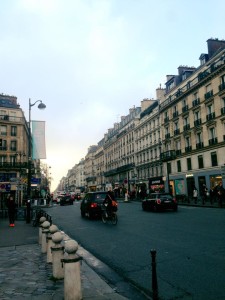
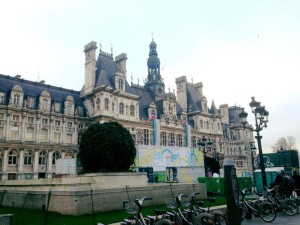 Place de la Republique i manifestanti iniziano a scaldarsi all’urlo di “Paris en Marche!” per l’inizio della “Conferenza Internazionale sul Clima” che terrà Parigi paralizzata per una giornata intera, il 29 Novembre, quando si conteranno 289 fermi e 174 arresti.
Place de la Republique i manifestanti iniziano a scaldarsi all’urlo di “Paris en Marche!” per l’inizio della “Conferenza Internazionale sul Clima” che terrà Parigi paralizzata per una giornata intera, il 29 Novembre, quando si conteranno 289 fermi e 174 arresti.